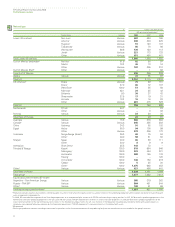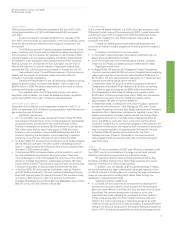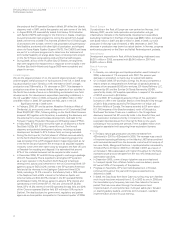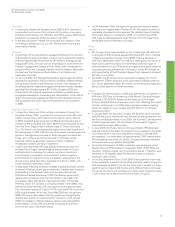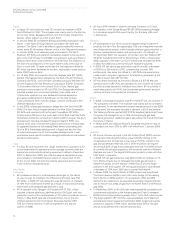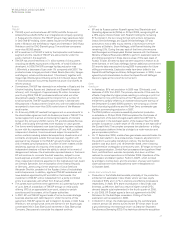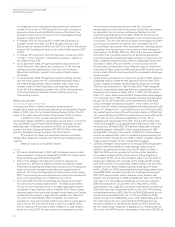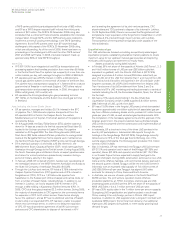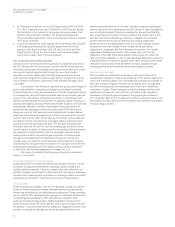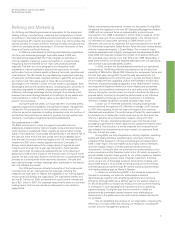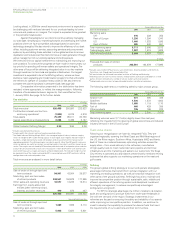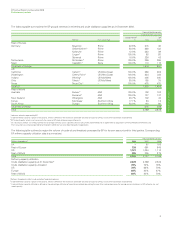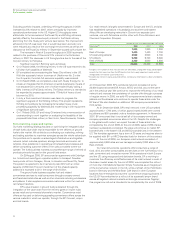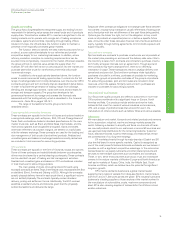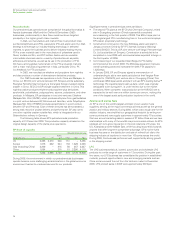BP 2008 Annual Report Download - page 27
Download and view the complete annual report
Please find page 27 of the 2008 BP annual report below. You can navigate through the pages in the report by either clicking on the pages listed below, or by using the keyword search tool below to find specific information within the annual report.
BP Annual Report and Accounts 2008
Performance review
Egypt
• In Egypt, BP net production was 121mboe/d, an increase of 25%
from 97mboe/d in 2007. This increase was mainly due to the start-up
of two new fields, Saqqara and Taurt, and the full-year impact from
Denise, which started up at the end of 2007.
• In January 2008, BP completed drilling a successful exploration well,
Satis-1, in the North El Burg offshore concession (BP 50% and
operator). The Satis-1 well was drilled in approximately 90 metres of
water, some 50 kilometres offshore, and is in the Oligocene formation.
• In January 2008, an oil discovery was announced in the North
Shadwan (BP 50% and operator) concession located in the southern
part of the Gulf of Suez. The NS394-1A exploration well was drilled in
shallow water seven kilometres from the Hilal field. This discovery is
the first new oil discovery in the south-eastern area of the Gulf of
Suez in more than 10 years and is also the first discovery drilled by
BP which has been facilitated by modern, high-quality, ocean-bottom
cable (OBC) seismic data.
• On 15 May 2008, oil production from the Saqqara field (BP 100%)
started. The Saqqara field, operated by the Gulf of Suez Petroleum
Company (GUPCO), a joint venture operating company between BP
and the Eygptian General Petroleum Corporation (EGPC), is located
13 kilometres offshore in the central Gulf of Suez. Natural gas
production commenced on 26 July 2008. The Saqqara development
includes a jacket and unmanned topsides, three wells, and a
13-kilometre pipeline to a new dedicated onshore separation
and gas processing plant at Ras Shukeir on the Gulf of Suez.
Local contractors were used for design, onshore construction and
offshore fabrication work.
• In July 2008, natural gas production began from the Taurt field (BP
50%). The Taurt field is located between the Ras El Bar Concession
(BP 50% and operator) and the Temsah Concession (BP 50%),
70 kilometres offshore to the north-east of Port Said, East Nile Delta.
Gross Taurt production ramped up to 230mmcf/d in August. The Taurt
development includes a Subsea Production System (SPS), two
subsea wells, and a 70-kilometre pipeline and control umbilical back
to upgraded facilities at the existing West Harbor processing plant.
Taurt is BP’s first subsea development in Egypt and also the first
of a planned programme of future subsea developments. Local
contractors were used for onshore design/modifications and subsea
structure construction.
Libya
• In Libya, BP and its partner, the Libyan Investment Corporation (LIC)
commenced seismic operations on the acreage covered under the
exploration and production-sharing agreement ratified in December
2007. In September 2008, the offshore seismic acquisition survey
commenced in the Mediterranean waters of Libya's Gulf of Sirt.
At the end of 2008, the onshore seismic operations commenced
in the northern Ghadames block.
Asia Pacific
Indonesia
• BP produces crude oil in, and supplies natural gas to, the island
of Java through its holding in the Offshore Northwest Java PSA
(BP 46%). In 2008, BP net production was 22mboe/d, an increase
of 18% from 18.6mboe/d in 2007 as a result of improved operating
efficiencies and increased gas demand in Java.
• BP is operator of the Tangguh LNG project (BP 37.2%), which
includes offshore platforms, pipelines and an LNG plant with two
production trains with a total capacity of 7.6 million tonnes per annum
(mtpa). In May 2008, gas was introduced from one of the two
offshore platforms into the Onshore Receiving Facility (ORF).
First commercial delivery of LNG is expected in the second
quarter of 2009.
• BP has a 50% interest in Virginia Indonesia Company LLC (Vico),
the operator of the Sanga-Sanga PSA (BP 38%) supplying feedgas
to Indonesia’s largest LNG export facility, the Bontang LNG plant
in Kalimantan.
Vietnam
• BP participates in one of the country’s largest foreign investment
projects, the Nam Con Son gas project. This is an integrated resource
and infrastructure project, which includes offshore gas production, a
pipeline transportation system and a power plant. At midnight on
31 December 2007, the operation of the Nam Con Son Pipeline (BP
32.67%) transferred from BP to PetroVietnam (PVN). In September
2008, capacity of the Nam Con Son Pipeline was increased by 30%
to allow for additional current and future expected volumes.
• In 2008, BP net natural gas production was 61mmcf/d, a decrease
of 26% from 82mmcf/d in 2007, primarily due to lower PSA
entitlements. Gas sales from Block 6.1 (BP 35% and operator) are
made under a long-term agreement for electricity generation at the
Phu My 3 power plant (BP 33.3%).
• BP has determined that its licences in Blocks 5.2 (BP 55.9% and
operator) and 5.3 (BP 75% and operator) do not fit within its current
portfolio and has decided to withdraw from them. BP is currently in
active discussions with PVN, the Vietnamese government and joint
venture partners to progress this withdrawal.
China
• In 2008, natural gas production was 91mmcf/d BP net, an increase of
7% compared with 2007. This increase was mainly due to increased
gas demand. A new development project was sanctioned in late 2008
to help meet the expected increase in demand in 2010 and beyond.
• The Yacheng offshore gas field (BP 34.3%) supplies Castle Peak Power
Company with feedgas for up to 70% of Hong Kong’s gas-fired
electricity generation. Additional gas is also sold to the Fuel & Chemical
Company of Hainan.
• In March 2007, the National People’s Congress reduced the rate of
corporation tax from 33% to 25% with effect from 1 January 2008.
Australia
• BP is one of seven partners in the North West Shelf (NWS) venture.
Six partners (including BP) hold an equal 16.67% interest in the
infrastructure and oil reserves and an equal 15.78% interest in the
gas and condensate reserves, with a seventh partner owning the
remaining 5.32% of gas and condensate reserves. The NWS venture
is currently the principal supplier to the domestic market in Western
Australia and one of the largest LNG export projects in Asia with five
LNG Trains in operation.
• In 2008, BP net gas production was 380mmcf/d, an increase of 1%
from 2007 primarily due to increased domestic gas demand in
Western Australia and the startup of NWS Train 5 and the Angel
platform in the third quarter. BP net liquids production was 29mb/d,
a decrease of 15% from 2007 due to natural field decline.
• In March 2008, the North Rankin 2 (NR2) project was sanctioned.
This links a second platform via a 100-metre bridge to the existing
North Rankin A (NRA) platform. On completion, NRA and NR2
platforms are expected to be operated as a single integrated facility
and to recover low pressure gas from the North Rankin and Perseus
gas fields.
• In September 2008, a fifth LNG train was successfully completed and
commenced production at the Karratha gas plant. Train 5 increases
NWS total annual production capacity from 11.9 to 16.3 million tonnes.
• The Angel platform (BP 16.67%) was successfully commissioned
and started producing gas during October 2008. Angel has a gross
production capacity of 800 million standard cubic feet of raw gas
and up to 50,000 barrels of condensate per day.
26








